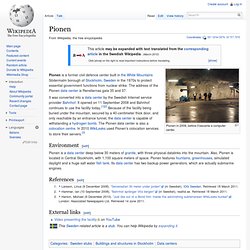

Centre de traitement de données. Un article de Wikipédia, l'encyclopédie libre.

Centre de traitement de données Un centre de traitement de données (data center en anglais) est un site physique sur lequel se trouvent regroupés des équipements constituants du système d’information de l’entreprise (ordinateurs centraux, serveurs, baies de stockage, équipements réseaux et de télécommunications, etc.). Il peut être interne et/ou externe à l’entreprise, exploité ou non avec le soutien de prestataires[1]. C'est un service généralement utilisé pour remplir une mission critique relative à l'informatique et à la télématique. Il comprend en général un contrôle sur l'environnement (climatisation, système de prévention contre l'incendie, etc.), une alimentation d'urgence et redondante, ainsi qu'une sécurité physique élevée. Des enjeux environnementaux sont liés à la consommation d'électricité des data centers, et à leur coproduit qu'est la chaleur, souvent dissipée par les serveurs. Description[modifier | modifier le code]
Facebook_sweden_data_center. Locations · Google Data Centers. Tech Titans Building Boom. The serene countryside around the Columbia River in the northwestern United States has emerged as a major, and perhaps unexpected, battleground among Internet powerhouses.

That’s where Google, Microsoft, Amazon, and Yahoo have built some of the world’s largest and most advanced computer facilities: colossal warehouses packed with tens of thousands of servers that will propel the next generation of Internet applications. Call it the data center arms race. The companies flocked to the region because of its affordable land, readily available fiber-optic connectivity, abundant water, and even more important, inexpensive electricity. These factors are critical to today’s large-scale data centers, whose sheer size and power needs eclipse those of the previous generation by one or even two orders of magnitude. These new data centers are the physical manifestation of what Internet companies are calling cloud computing. Pionen.
Pionen in 2006, before it became a computer center.

Pionen is a former civil defence center built in the White Mountains Södermalm borough of Stockholm, Sweden in the 1970s to protect essential government functions from nuclear strike. The address of the Pionen data center is Renstiernas gata 35 and 37. It was converted into a data center by the Swedish Internet service provider Bahnhof. It opened on 11 September 2008 and Bahnhof continues to use the facility today.[1][2] Because of the facility being buried under the mountain, secured by a 40-centimeter thick door, and only reachable by an entrance tunnel, the data center is capable of withstanding a hydrogen bomb. The Pionen data center is also a colocation centre. Environment[edit] Pionen is a data center deep below 30 meters of granite, with three physical datalinks into the mountain. References[edit] External links[edit] Video presenting the facility on YouTube Coordinates: WikiLeaks bunker - Mail Online. By Michael Hanlon Updated: 11:58 GMT, 9 December 2010 With his eccentric personal life and air of mystery, the flamboyant WikiLeaks founder Julian Assange seems to be doing his best to impersonate a James Bond villain.

How appropriate, then, that he has chosen what looks like an 007 film set as the back-up store for the thousands of confidential emails and documents that have shaken the world. These pictures show the Pionen data centre, 100ft below ground in a former Cold War nuclear bunker, where all the WikiLeaks files are being kept. Nerve centre: Super-servers which act for storage for many companies are also used by WikiLeaks to store its information U-boat back-up: Submarine engines are used as emergency generators at the Bahnhof internet service provider, in Stockholm, Sweden The vast cave, drilled into granite under the Vita Berg Park in Stockholm, houses dozens of computer servers used as storage by many companies. Mysterious: WikiLeaks founder Julian Assange Inspiration?